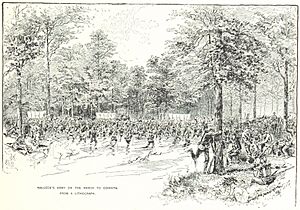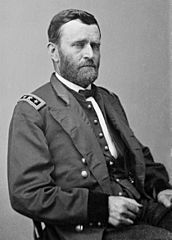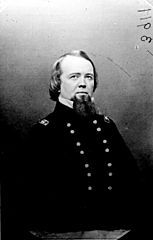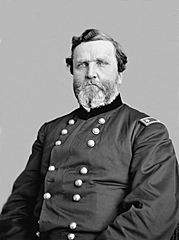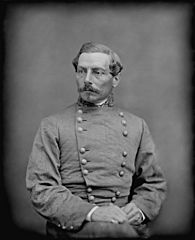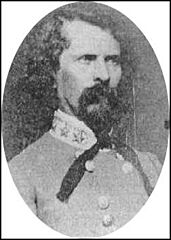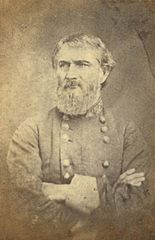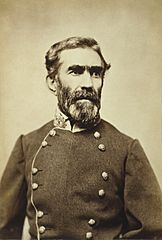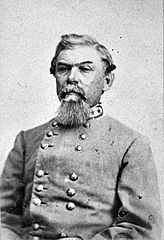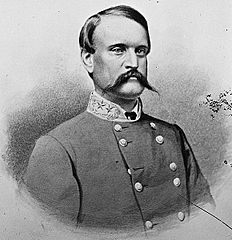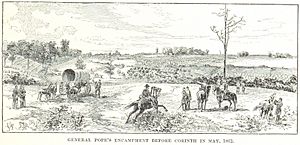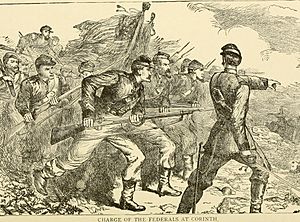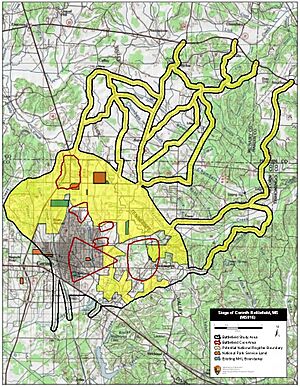Siege of Corinth facts for kids
Quick facts for kids Siege of Corinth |
|||||||
|---|---|---|---|---|---|---|---|
| Part of the American Civil War | |||||||
 Ohio troops at the battlefield of Corinth, taken December 1862, after the second battle fought at Corinth. |
|||||||
|
|||||||
| Belligerents | |||||||
| Commanders and leaders | |||||||
|
|||||||
| Units involved | |||||||
| Strength | |||||||
| 120,000 | 65,000 | ||||||
| Casualties and losses | |||||||
| 1,000+ | 1,000+ | ||||||
The Siege of Corinth was an important event in the American Civil War. It happened from April 29 to May 30, 1862, in Corinth, Mississippi. During this time, Union forces, led by Major General Henry Halleck, surrounded the city. The city was held by Confederate soldiers, commanded by General P.G.T. Beauregard.
Corinth was a very important place because two major railroad lines met there. These were the Mobile and Ohio Railroad and the Memphis and Charleston Railroad. Controlling these railroads was key for moving troops and supplies during the war. If the Union captured Corinth, it would make it harder for the Confederates to control the western areas.
The siege ended when the Confederate army, which had fewer soldiers, decided to leave on May 29. This meant the Confederates could not try to take back western Tennessee. Union forces, led by Ulysses S. Grant, then took over Corinth. They used it as a base to gain control of the Mississippi River Valley. This was especially important for attacking Vicksburg, Mississippi, a strong Confederate fort.
General William Tecumseh Sherman said that the battle changed how the war was fought in West Tennessee. He noted that the Union could now go on the attack instead of just defending.
Contents
Background to the Siege
Why Corinth Was Important
After the Union Army won the Battle of Shiloh in April 1862, Major General Henry Halleck gathered three Union armies. These were the Army of the Tennessee, the Army of the Ohio, and the Army of the Mississippi. His goal was to advance on Corinth, Mississippi, because of its important railroads.
Halleck was very careful after the many losses at Shiloh. He moved his army slowly, building defenses as they went. By May 25, 1862, his troops were ready to surround Corinth. The Confederate soldiers, led by Beauregard, were not doing well. They were outnumbered and many were sick with diseases like typhoid. Because of this, the Confederate leaders decided they could not hold the city.
Armies in the Battle
Union Forces
The Union's Department of the Mississippi was commanded by Major General Henry Halleck. It had about 120,000 soldiers ready for duty. This large force was split into three main parts:
- The Army of the Mississippi, known as the “Left Wing,” was led by Major General John Pope. It had about 21,510 soldiers.
- The Army of the Ohio, called the “Center Wing,” was led by Major General Don Carlos Buell. It had about 48,108 soldiers.
- The Army of the Tennessee, known as the “Right Wing,” was led by Major General George H. Thomas. It had about 50,554 soldiers.
| Key Union Commanders |
|---|
|
Confederate Forces
The Confederate Army of Mississippi was commanded by General P. G. T. Beauregard. He was in charge of all Confederate forces at Corinth. On April 30, this army had about 45,440 soldiers. It was divided into four corps (large groups of soldiers):
- I Corps, led by Major General Leonidas Polk.
- II Corps, led by Major General Braxton Bragg.
- III Corps, led by Major General William J. Hardee.
- The Reserve Corps, led by Brigadier General John C. Breckinridge.
The Army of the West, led by Major General Earl Van Dorn, had about 12,901 soldiers.
| Key Confederate Commanders |
|---|
|
Key Skirmishes and Movements
Farmington Skirmish
Major General John Pope was one of the most active Union commanders. On May 3, Pope's troops captured the town of Farmington, which was close to Corinth. However, General Halleck ordered Pope to pull back and join up with another Union group.
On May 9, Confederate General Pierre G. T. Beauregard ordered Earl Van Dorn to attack Pope's advanced troops. Pope successfully pulled his soldiers back and rejoined with General Buell. The Confederates had about 25,000 men, while the Union had 12,000. Both sides had some soldiers killed or wounded in this fight.
The 8th Wisconsin Volunteer Infantry Regiment was sent to draw out the enemy. They reported 5 killed and many wounded. Old Abe, a famous screaming eagle, was with the Wisconsin 8th Infantry. The 5th Minnesota Infantry Regiment also joined the fight on May 28.
Russell's House Attack
As the Union armies got closer to Corinth, Major General William Tecumseh Sherman suggested a plan. He wanted to attack a strong Confederate position at the Russell house. On May 17, the attack began. The Confederates fought hard, even firing from inside the house.
Union forces, with help from artillery, eventually pushed the Confederates back. Sherman's side had 10 killed and 31 wounded. The Confederates left 12 dead soldiers behind. This attack helped the Union gain important ground.
Double Log House Capture
On May 27, Halleck ordered Major General William T. Sherman to capture a log house. This house was along the Corinth Road and had been turned into a strong blockhouse by the Confederates. Sherman's troops quickly attacked and took the house.
The Confederates tried to counterattack, but the Union soldiers, supported by artillery, held their new position. The next day, Sherman's division moved forward to this spot. It gave them a good view of Corinth itself. Generals Ulysses S. Grant and George H. Thomas were there and approved of the operation.
Surratt's Hill Seizure
Confederate soldiers had been using a hill near the Widow Surratt farm as an outpost. Halleck ordered General Buell to clear the Confederates from this hill. Buell chose Major General Alexander M. McCook's division for the task.
On May 27, McCook's brigades attacked the hill. They intended to surprise the Confederates with their large force. The Union soldiers quickly took the hill. McCook's division then dug in and brought up heavy artillery. They immediately started shelling the Confederates. This capture allowed Halleck to bring up even bigger siege guns to bombard Corinth.
Confederate Retreat
With the Union army ready to fully surround the town, the Confederate leaders decided to retreat. Confederate commander General P. G. T. Beauregard used a clever trick to save his army. He gave some soldiers three days' worth of food and told them to get ready for an attack. As he expected, some of these soldiers went to the Union side and shared this news.
The Union forces began their bombardment, getting ready for a big fight. But during the night of May 29, the Confederate army quietly left. They used the Mobile and Ohio Railroad to move their sick, wounded, heavy guns, and supplies. When a train arrived, the troops cheered loudly, making it sound like more soldiers were arriving. They also set up fake cannons made of logs, called Quaker Guns, along their defenses. Campfires were kept burning, and buglers and drummers played music.
All these tricks made the Union believe the Confederates were still there and getting ready to fight. Meanwhile, the rest of the Confederate soldiers slipped away without being noticed. They retreated to Tupelo, Mississippi. When Union patrols entered Corinth on the morning of May 30, they found the city empty. The Union forces took control of Corinth. It became their base for future operations to control the Mississippi River Valley, especially the Confederate stronghold of Vicksburg, Mississippi.
Aftermath of the Siege
The Union victory at Corinth was very important. It helped the Union gain control of key railroad lines and move closer to controlling the Mississippi River.
Later, in October 1862, a Confederate army led by Major General Earl Van Dorn tried to take Corinth back. However, they were defeated in the Second Battle of Corinth by a Union army under General William S. Rosecrans. Even though the Confederates seemed to be winning at times, they failed to fully use their advantages. This led to a big defeat for them in that area.
Controlling Corinth was a major step for the Union. It helped them open up the Mississippi River Valley, which was a huge goal for the Union war effort.
Preservation
The American Battlefield Trust and its partners have worked to protect parts of the Corinth battlefield. By mid-2023, they had saved over 820 acres of this historic land.
See also
 In Spanish: Asedio de Corinth para niños
In Spanish: Asedio de Corinth para niños


